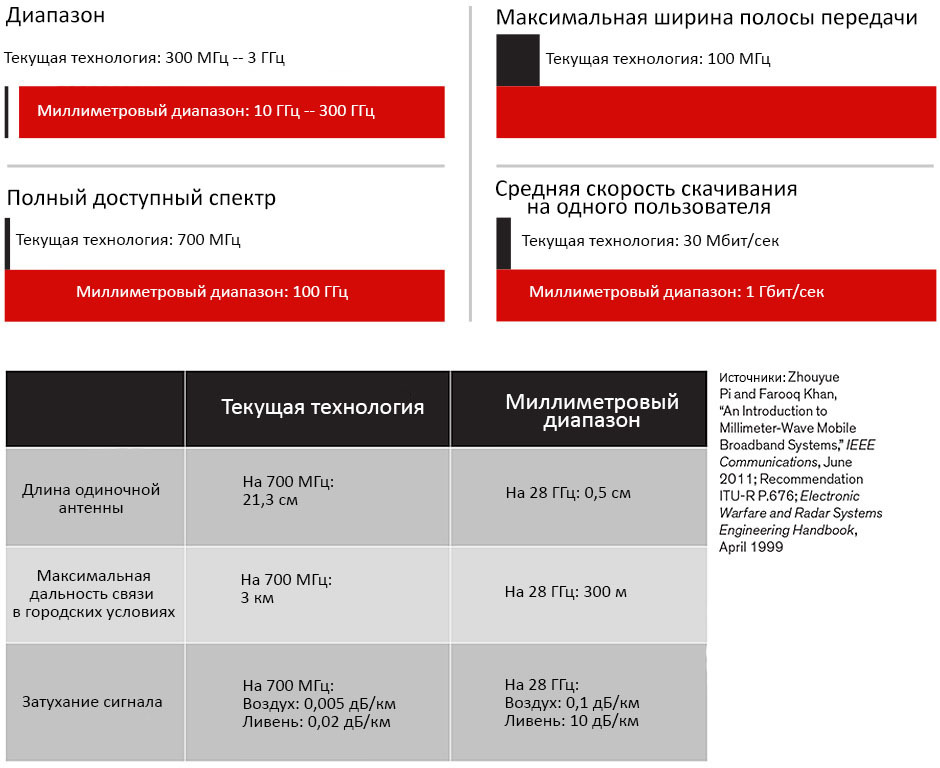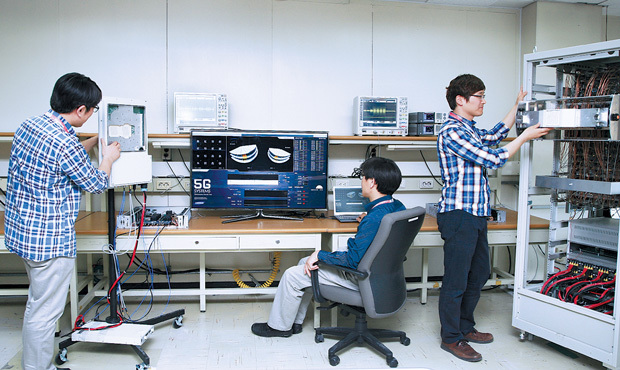Smart antennas help make 5G affordable (part 2)
 In the previous part of the translation article, we talked about the prospects for using the millimeter range to create new generation communication networks and the current state of affairs in this area. The second part describes the various experiments to test the range and stability of communication in the millimeter range. We will also finally find out if these frequencies can form the basis of a new generation of networks.
In the previous part of the translation article, we talked about the prospects for using the millimeter range to create new generation communication networks and the current state of affairs in this area. The second part describes the various experiments to test the range and stability of communication in the millimeter range. We will also finally find out if these frequencies can form the basis of a new generation of networks.Experimental results
How true are the concerns about poor coverage and the low penetrating power of millimeter waves? In 2011, the University of Texas conducted experiments to find out how millimeter waves scattered and reflected by various objects in their path, how quickly the signal loses energy. Receiving horn antennas were used, which were a development of the Boche design used more than 100 years ago. Such an antenna forms a directional concentrated beam without increasing the power of the transmitter or receiver. Four antennas were placed on rotating robotic platforms to guide the signal in any direction.
Such beam control can be a key feature of future millimeter-sized cellular communication systems. And both at base stations and end devices. But for this purpose it is necessary to introduce arrays of electronically controlled antennas into smartphones and tablets.
In total, more than 700 combinations of transmitters and receivers were tested. The frequency of the signal was about 38 GHz. This part of the range is a good candidate for cellular use, because it is already allocated for commercial use in many countries.
')
In the course of the experiments it was found that millimeter waves provide a very good level of coverage . In particular, there was no need to maintain direct visibility between the receiver and the transmitter; the high ability to reflect turned out to be an advantage and not a disadvantage of waves in this range.
Of course, as is the case with any wireless system, the probability of signal loss increased as the receiver moved away from the transmitter. In the case of a low-power signal, interruptions began at approximately 200 meters. For early generations of cellular communication, this would have been a problem, but in recent years, operators have been forced to reduce cell sizes in order to increase capacity. In the most densely populated areas, for example, in the center of Seoul, ultra-small cells began to be created on the basis of compact base stations that fit on a lamppost or a kiosk at a bus stop. Such cells operate at a distance of no more than 100 meters.
Another argument in favor of small cells is the dispersing effect of rain on millimeter waves, they lose energy faster than decimeter waves. However, studies have shown that at a distance of several hundred meters this effect is insignificant. Although there are a few exceptions.
Then the same experiment, with the same equipment, was conducted in New York, one of the most radio-saturated cities in the world. During 2012-2013, the behavior of waves at frequencies of 28 and 73 GHz, also allocated for commercial use, was studied. The result was almost the same . Even on the streets of Manhattan, at a distance of 200 meters, communication was maintained for 85% of the time. More accurate antenna arrays will be able to increase the distance of stable communication over 300 meters.

Comparison of current decimeter technology and future millimeter.
It was also found that the waves of these frequencies pass through drywall and glass with a small loss of energy. Brick, concrete and heavily tinted glass almost completely block them. Therefore, depending on the building design, operators may need to install repeaters in order to provide indoor communications.
New research
Inspired by the results described above, researchers from the University of Texas, together with Samsung experts, began to create a prototype communication system . Instead of bulky motorized horn antennas, arrays of rectangular metal plates called patch antennas were used. Their big advantage is the small size, which must necessarily be half the wavelength. The prototype was created under the signal at 28 GHz (about 1 cm), so each patch antenna was no more than 5 mm.
Such arrays of antennas (phased antenna arrays) have long been successfully used in radars and space communications, and many chip makers, including Intel, Qualcomm and Samsung, are introducing them into WiGig chipsets today. Thanks to the electronic control signal of each antenna, such arrays allow you to quickly rebuild the beam and send it to a specific device.
An array that can hold a beam on a moving object is called adaptive, or “smart.” The larger the array, the narrower the beam. To tune the beam, the array changes the amplitude or phase (or both) of the signal from each antenna. With reference to the cellular network, the base station and the end device establish a connection, “groping” for each other, determining in which direction the signal is strongest. After that, a communication channel is established.
Such formation and control of the beam can be implemented in two ways.
The first method : an analog signal right before transmission (or immediately after reception) is processed by digital phase controllers or amplifiers.
The second way : processing takes place in digital form before converting to analogue (or after digitizing).
Each approach has its pros and cons.
Digital beamforming gives higher accuracy. But it is more complicated and, therefore, more expensive, since it requires separate computational modules and “voracious” digital-analog (or analog-to-digital) converters for each patch antenna.
In contrast, analog beamforming is simpler and cheaper because fixed components are used for this. But this method is less flexible.

To take the best of both methods, a hybrid architecture was used in the prototype. In particular, phase regulators on the analog front end were used to form narrow directional beams, which made it possible to increase the communication range. In the back end, digital processing was applied to separate control of different sections of the array. Digital input made it possible to send several rays simultaneously to several end devices, or to concentrate all the rays on a single device. That is, the MIMO method was applied.
The array of 64 antennas was the size of a note sheet. It was divided into two MIMO channels, each of which used a 500 MHz band and could form a beam with a width of 10 degrees. Under laboratory conditions, these two beams made it possible to provide almost error-free data transmission at a speed of more than 500 Mbit / s to two mobile stations simultaneously. Both beams directed to one station allowed transmitting data at a speed of more than 1 Gbit / s. For comparison, in New York, the average speed in LTE networks is about 10 Mbit / s, and in theory it can reach 50 Mbit / s.
The prototype provided a stable connection when moving mobile stations in random directions at a speed of up to 8 km / h. Communication was maintained at a distance of almost 300 m beyond direct visibility. And in the absence of obstacles between the receiver and the transmitter, the communication range increased to 2 km.
Please note that this prototype was created just to prove the concept. If you use a wider band, narrower beams and increase the number of MIMO channels, then you can achieve much higher results in transmission speed and communication range. Computer simulation has shown that in real-world conditions, it is possible to fully ensure the transfer rate at the level of several gigabits per second.
But there is one important limitation - where to get free space to place the antenna array in smartphones and tablets? The Samsung Galaxy Note II managed to cram in 32 antennas at the top and bottom of the device, which provided a 360 degree coverage.
Conclusion
All these numerous experiments give every reason to believe that cellular communication based on the millimeter range is not just possible, it will be a breakthrough. Of course, the works are still at the initial stage. To create a full-size network engineering model, it will be necessary to develop millimeter-channel statistical models, beam forming algorithms, new energy-efficient standards, and much more. Government organizations should also be involved in this process.
Now various industrial groups around the world are already looking for candidates for the role of "5G technologies", including interference control schemes and dense architectures based on small cells. And the understanding is already coming that the millimeter range is the key component capable of combining all sorts of ingredients.
- Of course, it is too early to talk about the timing, but even about some specific technologies that will form the basis of 5G. Millimeter range can not be called completely suitable for the organization of cellular communication. But it is quite possible that its advantages will outweigh the disadvantages, and the developers will figure out how to compensate for the most important "inconveniences." We, in turn, would like to know the opinion of Russian specialists regarding the prospects for using the millimeter range. Do you consider him the main candidate for the role of 5G technology, and why? Perhaps you have your own experience with millimeter equipment? It would be great if you told about it in the comments.
Source: https://habr.com/ru/post/239037/
All Articles